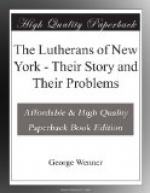2. Tradition, from the civil and social arrangements of the national churches from which we are descended, inherited through generations of our predecessors in this country. We follow in the old ruts, and “the way we have always been doing” puts an end to controversy.
3. Environment. Consciously or unconsciously we are influenced by the practice of neighboring denominations.
The object of this chapter is to ascertain the historic principles of the Lutheran Church in regard to church membership, to test their validity by Scriptures and to apply them to present conditions.
The Church is primarily the communion of saints. Thus in the Small Catechism: “even as He (the Holy Ghost) ... sanctifies the whole Christian Church on earth.” In the Large Catechism the same thought, that the Church is the product of the Holy Ghost, is expressed in ample terms. Rome’s doctrine of the Church, as essentially an external organism, was answered in the 7th Article of the Augustana with the statement that the Church is the “congregation of saints,” and this Article was the object of special attack in the Confutation. In the Apologia the Church is the congregation of those who confess one Gospel, have a knowledge of Christ and a Holy Spirit who renews, sanctifies and governs their hearts (Mueller 153, 8). In the Smalcald Articles: “Thank God, a child of seven years knows what the Church is, namely the holy believers and the lambs who hear their Shepherd’s voice.” The Formula of Concord has no special article on the Church, but touches the question incidentally and confirms the statements of the other symbols. (See Rohnert, Dogmatik, p. 505.)
These teachings are in harmony with New Testament doctrine. Jesus said: “Upon this rock will I build my church,” the congregation of God’s children, the spiritual house which in the years to come “I will build.” This Church was founded through the outpouring of the Holy Ghost on Pentecost. When the Epistles were written Ecclesia had become the established term. In Acts 2, 42, we find that Koinonia was one of the essential characteristics of the Church. John uses the same term in his first letter. This is the very truth repeated in the 7th Article of the Augustana. Paul, in his letter to Titus, refers to Christians as those who have believed in God; Romans 8, “God’s elect;” also in Colossians 3, 1, “elect of God;” I. Peter 2, “holy nation, peculiar people;” I. Cor. 1, “Sanctified in Christ Jesus,” etc., etc. They form a “spiritual house,” I. Peter, 2; “God’s building,” I. Cor, 3; “body of Christ” in process of edification, Eph. 4. This body of Christ is an organic unity in which the Holy Ghost dwells as in a temple, I. Cor., 3 ; and of which Christ is the head, Eph. 1, 22. The Church is the “bride of Christ,” II. Cor, 11, 2; destined to be “holy and without blemish,” Eph., 5, 27.
The Romish doctrine of the Church began with Cyprian in the third century. When the Puritans of that day, the Montanists, Novatians and Donatists unduly emphasized the ideal character of the Church, there was justification for the answer of Cyprian, emphasizing its empiric character, its actual condition. When after thirteen centuries of abuse of this position a Reformation occurred, it was to be expected that the Reformers would first of all emphasize the ideal, the inner character of the Church.




